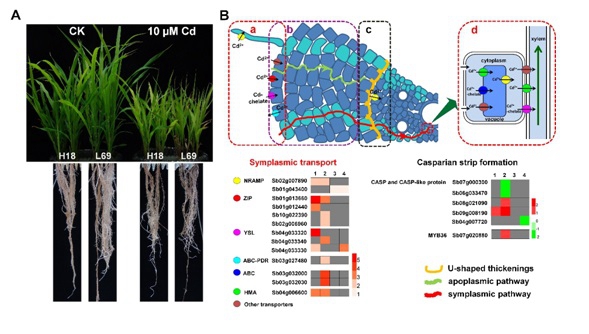
Cadmium (Cd) contamination in soil seriously threatens food production as well as human health, thus the effective way to remediate Cd contamination has attracted increasing attention.
Sweet sorghum (Sorghum bicolor (L.) Moench), a C4 plant with high photosynthetic efficiency and widely cultivated, has high biomass yield and high sugar content in its stalk, making it an ideal feedstock for ethanol production.
In addition, it is tolerant to abiotic stresses such as salt, drought, heat, and toxic pollution. Sweet sorghum can absorb Cd from Cd-contaminated soils, therefore, cultivating sweet sorghum in the soils not only provides feedstock for ethanol production, but also achieves the goal of phytoremediation.
Furthermore, the derived fibrous residues can be burned to produce electricity or process heat, after which Cd left in ash can be recycled. Through this process, Cd can be transferred from the food chain into the energy chain, thus avoiding the harm to human beings. Previous studies on the response of sweet sorghum to Cd stress were mostly descriptive and stayed on the physiological level.
What's more, as non-hyperaccumulator, most of the absorbed Cd was retained in the roots of sweet sorghum plants. In order to improve the capacity of phytoremediation, it is of great importance to dissect the molecular mechanisms of Cd accumulation in sweet sorghum and promote the capacity of Cd translocation in its shoots.
Prof. LI Yinxin's group at the Institute of Botany of the Chinese Academy of Sciences screened 96 sweet sorghum genotypes from worldwide for their capacity of Cd accumulation, translocation
They further used high-Cd accumulation genotype H18 and low-Cd accumulation one L69 to investigate key factors responsible for Cd accumulation and translocation in sweet sorghum.
Results showed that H18 exhibited a much higher ability of Cd uptake and translocation than L69. Furthermore, Cd uptake through symplasmic pathway and Cd concentrations in xylem sap were both higher in H18. The endodermal apoplasmic barriers were much stronger in L69, which may restrict the Cd loading into xylem.
Comparative transcriptome analysis found many genes involved in cell wall modification and heavy metal transport to be Cd-responsive DEGs and/or DEGs between these two genotypes. KEGG pathway analysis found phenylpropanoid biosynthesis pathway was over-represented, indicating this pathway may play important roles in differential Cd accumulation between two genotypes.
Based on these results, they proposed that higher Cd accumulation in H18 depends on a multi-level co-ordination of efficient Cd uptake and transport, including efficient root uptake and xylem loading, less root cell wall binding, and weaker endodermal apoplasmic barriers.
These results not only lay the foundation for further exploring the molecular mechanisms of Cd accumulation in plants, but also provide new strategies for improving phytoremediation ability of energy plants through genetic engineering.
This work was published in Plant Biotechnology Journal. The research on sweet sorghum genotype screening was published in Ecotoxicology and Environmental Safety
This research was financially supported by National Key R&D Program of China and the Science and Technology Program for Public Wellbeing.

Key factors for cadmium accumulation in sweet sorghum (Image by LI Yinxin)

86-10-68597521 (day)
86-10-68597289 (night)

86-10-68511095 (day)
86-10-68512458 (night)

cas_en@cas.cn

52 Sanlihe Rd., Xicheng District,
Beijing, China (100864)

